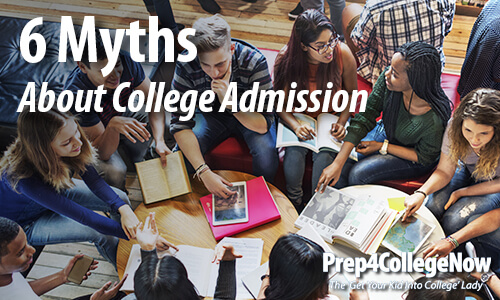6 Myths about College Admission
Myth #1: Only Top Tier Schools Prepare People for Success
The most pervasive myth is if your teen doesn’t attend one of the top 20 Newsweek-rated colleges (aka Ivies), then they won’t have an opportunity for jobs, promotions and influence. Over half of our U.S. Senators graduated from public universities. 43 of the top 50 CEOs in the world graduated from schools other than Ivies. Part of the fabric of the American dream is the opportunity presented to you and what you do with it, not where you went to college.
Myth # 2: A College Brochure in the Mail Means Something
Many colleges send out glossy brochures trying to attract students to apply. Receiving a brochure does not mean a letter of acceptance will ensue. The truth is the college only wants the student to apply. The more applications it receives, the more it can reject. The more it rejects, the higher the school’s ranking goes up in Newsweek. Ranking sells and is highly valued by the colleges.
Myth #3: Applying to More Schools Increases One’s Chances
Many parents think that if their teenager applies to more highly selective colleges, it increases her chances of getting accepted. That is not the case. Your teen should apply to more schools where her GPA and test scores (ACT and SAT) fall into the median range. Your teen will then apply to at least six schools where she is competitive. By doing so, she increases her chances of getting in.
Myth #4: Once You Send the Application In, You’re Done
Once your teen hits the send button, it is a great relief. However, the process of getting admitted has just started. Colleges care about two things, demonstrated interest and yield. Demonstrated interest means your teen lets the college know she likes them. She visits the campus. She meets the admission officer. She stays in contact via e-mail or phone. Yield involves the likelihood a student will get enrolled. By following the above suggestions, your teen increases the likelihood of acceptance, especially if she is on the bubble (grades and scores are just borderline on the acceptance curve). Colleges do keep track of this stuff.
Myth #5: Large Universities Offer More Opportunities than Small Liberal Arts Colleges
There is a common misconception that small liberal arts colleges have fewer resources than those offered by a big university. Often the opposite is true. It is important to look beyond the advertised opportunities and ask how many students use them. It is also significantly easier to build relationships with professors and get involved in research at a smaller college.
Myth #6: Colleges are Looking for Well Rounded Students
While it is true colleges want students who aren’t focused on one thing, the truth is, “well –rounded” students are not what college admission officers are looking for. The reality is they are looking for well-rounded classes. They care mostly about the freshmen class profile. They like students from all parts of the country with a variety of traits. Sometimes, a rejection letter has nothing to do with the student, but everything to do with the class profile. The student needs to understand that and be okay with writing a paper attending schools not of their first choice. Having the right attitude and approach can make a world of difference in how your teen deals with rejection and acceptance.
________________________________
Excerpted from an article from About.com, written by Josh Bottomly



Leave A Comment